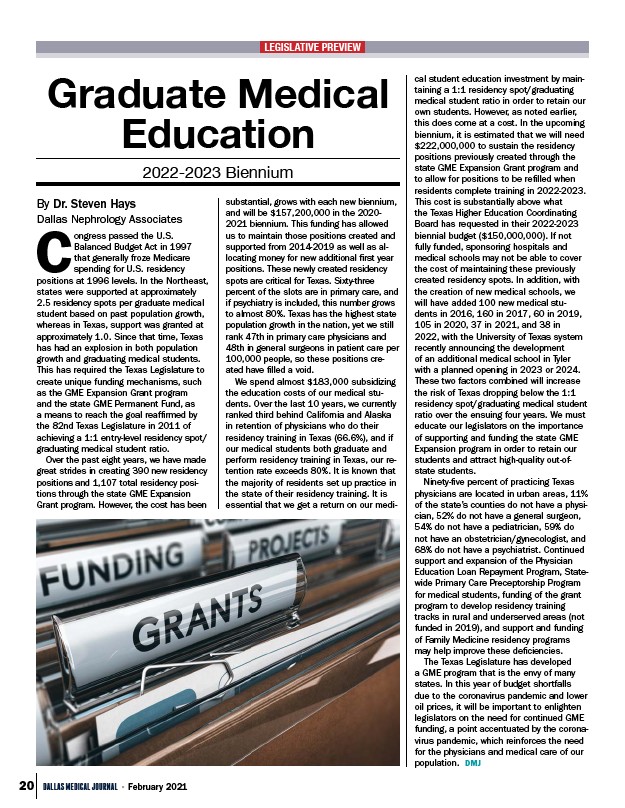
Congress passed the U.S.
Balanced Budget Act in 1997
that generally froze Medicare
spending for U.S. residency
positions at 1996 levels. In the Northeast,
states were supported at approximately
2.5 residency spots per graduate medical
student based on past population growth,
whereas in Texas, support was granted at
approximately 1.0. Since that time, Texas
has had an explosion in both population
growth and graduating medical students.
This has required the Texas Legislature to
create unique funding mechanisms, such
as the GME Expansion Grant program
and the state GME Permanent Fund, as
a means to reach the goal reaffirmed by
the 82nd Texas Legislature in 2011 of
achieving a 1:1 entry-level residency spot/
graduating medical student ratio.
Over the past eight years, we have made
great strides in creating 390 new residency
positions and 1,107 total residency positions
through the state GME Expansion
Grant program. However, the cost has been
20 DALLAS MEDICAL JOURNAL • February 2021
substantial, grows with each new biennium,
and will be $157,200,000 in the 2020-
2021 biennium. This funding has allowed
us to maintain those positions created and
supported from 2014-2019 as well as allocating
money for new additional first year
positions. These newly created residency
spots are critical for Texas. Sixty-three
percent of the slots are in primary care, and
if psychiatry is included, this number grows
to almost 80%. Texas has the highest state
population growth in the nation, yet we still
rank 47th in primary care physicians and
48th in general surgeons in patient care per
100,000 people, so these positions created
have filled a void.
We spend almost $183,000 subsidizing
the education costs of our medical students.
Over the last 10 years, we currently
ranked third behind California and Alaska
in retention of physicians who do their
residency training in Texas (66.6%), and if
our medical students both graduate and
perform residency training in Texas, our retention
rate exceeds 80%. It is known that
the majority of residents set up practice in
the state of their residency training. It is
essential that we get a return on our medical
student education investment by maintaining
a 1:1 residency spot/graduating
medical student ratio in order to retain our
own students. However, as noted earlier,
this does come at a cost. In the upcoming
biennium, it is estimated that we will need
$222,000,000 to sustain the residency
positions previously created through the
state GME Expansion Grant program and
to allow for positions to be refilled when
residents complete training in 2022-2023.
This cost is substantially above what
the Texas Higher Education Coordinating
Board has requested in their 2022-2023
biennial budget ($150,000,000). If not
fully funded, sponsoring hospitals and
medical schools may not be able to cover
the cost of maintaining these previously
created residency spots. In addition, with
the creation of new medical schools, we
will have added 100 new medical students
in 2016, 160 in 2017, 60 in 2019,
105 in 2020, 37 in 2021, and 38 in
2022, with the University of Texas system
recently announcing the development
of an additional medical school in Tyler
with a planned opening in 2023 or 2024.
These two factors combined will increase
the risk of Texas dropping below the 1:1
residency spot/graduating medical student
ratio over the ensuing four years. We must
educate our legislators on the importance
of supporting and funding the state GME
Expansion program in order to retain our
students and attract high-quality out-ofstate
students.
Ninety-five percent of practicing Texas
physicians are located in urban areas, 11%
of the state’s counties do not have a physician,
52% do not have a general surgeon,
54% do not have a pediatrician, 59% do
not have an obstetrician/gynecologist, and
68% do not have a psychiatrist. Continued
support and expansion of the Physician
Education Loan Repayment Program, Statewide
Primary Care Preceptorship Program
for medical students, funding of the grant
program to develop residency training
tracks in rural and underserved areas (not
funded in 2019), and support and funding
of Family Medicine residency programs
may help improve these deficiencies.
The Texas Legislature has developed
a GME program that is the envy of many
states. In this year of budget shortfalls
due to the coronavirus pandemic and lower
oil prices, it will be important to enlighten
legislators on the need for continued GME
funding, a point accentuated by the coronavirus
pandemic, which reinforces the need
for the physicians and medical care of our
population. DMJ
LEGISLATIVE PREVIEW
Graduate Medical
Education
2022-2023 Biennium
By Dr. Steven Hays
Dallas Nephrology Associates